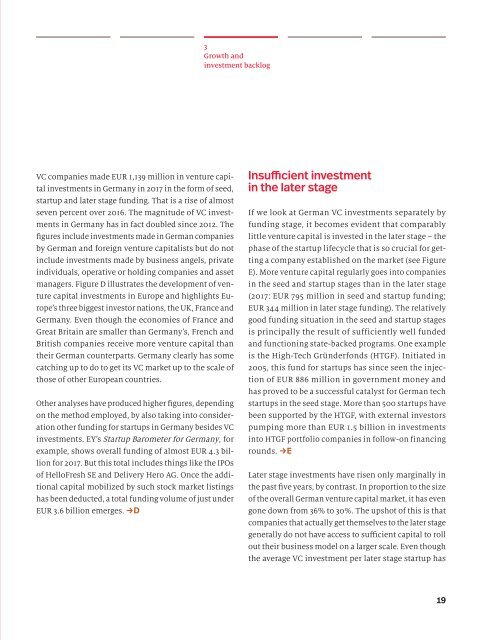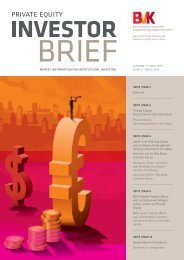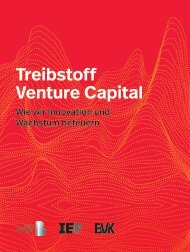Treibstoff Venture Capital (Fuel Venture Capital): Fueling innovation and economic growth
There is a lack of venture capital (VC) in Germany, especially in the growth phase of newly founded companies. As a result, the necessary capital to establish successful companies from innovative business models is lacking. In view of the international competition between technology locations, this lack weakens the innovative power of the European economy and hinders sustainable growth. The new study "Fuel Venture Capital: How we fuel innovation and growth" by Roland Berger, the Internet Economy Foundation (IE.F) and the Bundesverband Deutscher Kapitalbeteiligungsgesellschaften e.V. (Association of German Private Equity Firms). (BVK) analyses existing investment barriers to venture capital and explains how these can be overcome.
There is a lack of venture capital (VC) in Germany, especially in the growth phase of newly founded companies. As a result, the necessary capital to establish successful companies from innovative business models is lacking. In view of the international competition between technology locations, this lack weakens the innovative power of the European economy and hinders sustainable growth. The new study "Fuel Venture Capital: How we fuel innovation and growth" by Roland Berger, the Internet Economy Foundation (IE.F) and the Bundesverband Deutscher Kapitalbeteiligungsgesellschaften e.V. (Association of German Private Equity Firms). (BVK) analyses existing investment barriers to venture capital and explains how these can be overcome.
You also want an ePaper? Increase the reach of your titles
YUMPU automatically turns print PDFs into web optimized ePapers that Google loves.
3<br />
Growth <strong>and</strong><br />
investment backlog<br />
VC companies made EUR 1,139 million in venture capital<br />
investments in Germany in 2017 in the form of seed,<br />
startup <strong>and</strong> later stage funding. That is a rise of almost<br />
seven percent over 2016. The magnitude of VC investments<br />
in Germany has in fact doubled since 2012. The<br />
figures include investments made in German companies<br />
by German <strong>and</strong> foreign venture capitalists but do not<br />
include investments made by business angels, private<br />
individuals, operative or holding companies <strong>and</strong> asset<br />
managers. Figure D illustrates the development of venture<br />
capital investments in Europe <strong>and</strong> highlights Europe’s<br />
three biggest investor nations, the UK, France <strong>and</strong><br />
Germany. Even though the economies of France <strong>and</strong><br />
Great Britain are smaller than Germany’s, French <strong>and</strong><br />
British companies receive more venture capital than<br />
their German counterparts. Germany clearly has some<br />
catching up to do to get its VC market up to the scale of<br />
those of other European countries.<br />
Other analyses have produced higher figures, depending<br />
on the method employed, by also taking into consideration<br />
other funding for startups in Germany besides VC<br />
investments. EY’s Startup Barometer for Germany, for<br />
example, shows overall funding of almost EUR 4.3 billion<br />
for 2017. But this total includes things like the IPOs<br />
of HelloFresh SE <strong>and</strong> Delivery Hero AG. Once the additional<br />
capital mobilized by such stock market listings<br />
has been deducted, a total funding volume of just under<br />
EUR 3.6 billion emerges. →D<br />
Insufficient investment<br />
in the later stage<br />
If we look at German VC investments separately by<br />
funding stage, it becomes evident that comparably<br />
little venture capital is invested in the later stage – the<br />
phase of the startup lifecycle that is so crucial for getting<br />
a company established on the market (see Figure<br />
E). More venture capital regularly goes into companies<br />
in the seed <strong>and</strong> startup stages than in the later stage<br />
(2017: EUR 795 million in seed <strong>and</strong> startup funding;<br />
EUR 344 million in later stage funding). The relatively<br />
good funding situation in the seed <strong>and</strong> startup stages<br />
is principally the result of sufficiently well funded<br />
<strong>and</strong> functioning state-backed programs. One example<br />
is the High-Tech Gründerfonds (HTGF). Initiated in<br />
2005, this fund for startups has since seen the injection<br />
of EUR 886 million in government money <strong>and</strong><br />
has proved to be a successful catalyst for German tech<br />
startups in the seed stage. More than 500 startups have<br />
been supported by the HTGF, with external investors<br />
pumping more than EUR 1.5 billion in investments<br />
into HTGF portfolio companies in follow-on financing<br />
rounds. →E<br />
Later stage investments have risen only marginally in<br />
the past five years, by contrast. In proportion to the size<br />
of the overall German venture capital market, it has even<br />
gone down from 36% to 30%. The upshot of this is that<br />
companies that actually get themselves to the later stage<br />
generally do not have access to sufficient capital to roll<br />
out their business model on a larger scale. Even though<br />
the average VC investment per later stage startup has<br />
19

















